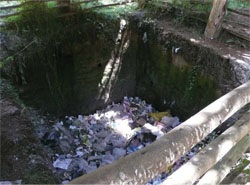22.3.4 Final disposal: landfill, controlled tipping and burning
Sanitary landfill means the controlled filling of compacted layers of solid waste and soil into pre-prepared land. Large-scale landfill sites for municipal waste need to be designed to protect surface and groundwater from contamination by leachate, the liquid waste that may seep out into the ground underneath the layers of waste. Sanitary landfill sites are not just rubbish dumps for open field dumping. To be classed as sanitary the site must be managed to minimise any negative environmental impact.
Controlled tipping or controlled burial is similar in principle to sanitary landfill but at a smaller scale that is appropriate in rural areas. In controlled tipping/burial, solid waste is disposed of into a dug pit and is regularly covered with soil to avoid attracting disease vectors such as flies and rodents. Covering the waste also stops it from being blown by the wind and avoids bad smells – hence ‘controlled’.
Note that various similar terms may be used to describe different types of waste disposal pit. A refuse pit is a simple pit used to dispose of household refuse, which may or may not be used for controlled tipping (with soil). Some wastes will need to be buried under soil as soon as they are disposed of, in which case the pit may be referred to as a burial pit.
When there is a need for preparing a refuse pit for households, you should advise them that sites for controlled tipping should be 10 m away from the house (preferably at the back of the house), at least 15 m and preferably 30–50 m away from water wells and at a lower ground level. At community level, a communal refuse pit should be 100 m away from houses and they will also need to consider the direction of wind. The site should be easily accessible, with adequate space, and should be fenced so that it is not accessible to children and domestic animals (Figure 22.6).

Care must be taken to avoid creating places that could harbour rats or encourage the breeding of flies and other insects. Waste from individual households should be taken to the site in suitable containers such as sacks, plastic bags or buckets. For a community waste disposal pit, it should be a collective responsibility to keep communal areas clean.
Animal carcasses need to be disposed of carefully because they can encourage the breeding of flies and rodents, and attract scavenger animals. They can be disposed of in a common burial pit for the community.
Burning of waste is another possible, though less desirable, method of final disposal. A burning site should be sited downwind and well away from houses. Non-combustible materials such as broken bottles, bones, etc. should be separated and buried at a safe location, not used by farming. Ashes that remain after burning can be used as fertiliser or, if mixed with mud, can be used for plastering of earth walls or floors.
22.3.3 Recovery strategies: recycling, composting and energy
